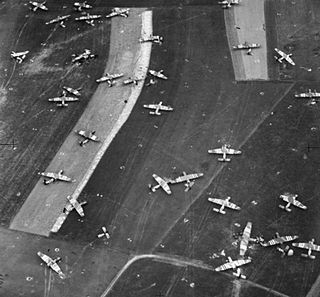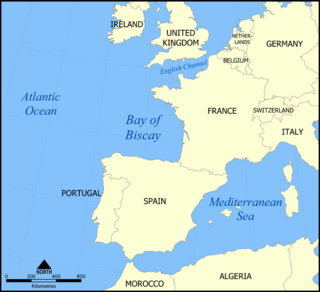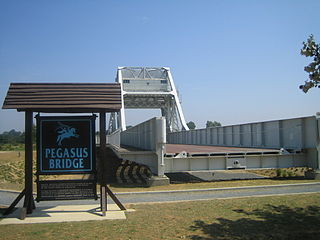
Hengist and Horsa are legendary brothers said to have led the Angles, Saxons and Jutes in their invasion of Britain in the 5th century. Tradition lists Hengist as the first of the Jutish kings of Kent.

Pegasus Bridge, originally called the Bénouville Bridge after the neighbouring village, is a road crossing over the Caen Canal, between Caen and Ouistreham in Normandy. The original bridge, built in 1934, is now a war memorial and is the centrepiece of the Memorial Pegasus museum at nearby Ranville. It was replaced in 1994 by a modern design which, like the old one, is a bascule bridge.

The 1st Airborne Division was an airborne infantry division of the British Army during the Second World War. The division was formed in late 1941 during World War II, after the British Prime Minister, Winston Churchill, demanded an airborne force, and was initially under command of Major-General Frederick A. M. Browning. The division was one of two airborne divisions raised by the British Army during the war, with the other being the 6th Airborne Division, created in May 1943, using former units of the 1st Airborne Division.

Bénouville is a commune in the Calvados department in the Normandy region in northwestern France.
Staff Sergeant James Harley Wallwork DFM was a British soldier and a member of the Glider Pilot Regiment who achieved notability as the pilot of the first Horsa glider to land at Pegasus Bridge in the early hours of D-Day, 6 June 1944, during the Second World War. This achievement was described as "the greatest feat of flying of the second world war" by Air Chief Marshal Sir Trafford Leigh-Mallory. Although most noted for his part in the Battle of Normandy, Wallwork flew gliders in every major British airborne operation of the Second World War. These also included the Sicily landings, Arnhem and the Rhine Crossings. In later life he lived in Vancouver.

The 1st Airlanding Brigade was an airborne infantry brigade of the British Army during the Second World War and the only glider infantry formation assigned to the 1st Airborne Division, serving alongside the 1st and 4th Parachute Brigades.
No. 299 Squadron was a Royal Air Force squadron during the Second World War and was part of No. 38 Group.
No. 298 Squadron was a Royal Air Force special operations squadron during the Second World War. Later in that war it changed to the transport role, disbanding after the end of the hostilities.
Airlanding is a designation formerly held by glider-borne infantry units British Army. Airlanding units included infantry battalions and light armoured regiments together with combat support and combat service support units and sub-units. The Glider Pilot Regiment provided the aircrew to fly the gliders into battle. Although combat support and combat service support units had the term airlanding as part of their unit title, for example 1st Airlanding Light Regiment Royal Artillery, infantry battalions' names remained unchanged. All units wore the maroon beret of airborne forces with their own regimental capbadge.
No 297 Squadron was a squadron of the Royal Air Force. It was notable for being the first airborne forces squadron formed. With sister No 296 Squadron it formed No 38 Wing RAF in January 1942, joined in August by No 295 Squadron; the Wing expanded in 1943 to become No 38 Group RAF. The squadron saw action in Sicily and took part in the D-Day invasion and Operation Market Garden. It was disbanded in 1950.
Colonel Henry John Sweeney MC, known as Tod Sweeney, was an officer of the British Army. During the Second World War he was a platoon commander in the coup de main operation, by gliderborne troops of the 2nd Battalion, Oxfordshire and Buckinghamshire Light Infantry, on D-Day, 6 June 1944, tasked to seize Horsa Bridge and Pegasus Bridge before the main assault on the Normandy beaches began. The following day he was awarded the Military Cross for rescuing a wounded member of his platoon while under heavy fire near Escoville. Sweeney commanded the 1st Green Jackets at Penang from April 1962 to January 1964; during the Brunei Revolt and Indonesia-Malaysia confrontation.
Colonel David James Wood MBE was the last surviving officer of the coup de main operation carried out by glider borne troops of the 2nd Oxfordshire and Buckinghamshire Light Infantry, on D Day, 6 June 1944, tasked with capturing Pegasus Bridge and Horsa Bridge before the main assault on the Normandy beaches began.

Operation Mallard was the codename for an airborne forces operation, which was conducted by the British Army on 6 June 1944, as part of the Normandy landings during the Second World War.

Operation Deadstick was the codename for an operation by airborne forces of the British Army that took place in the early hours of 6 June 1944 as part of the Normandy landings of the Second World War. The objective was to capture intact two road bridges in Normandy across the River Orne and the Caen Canal, providing the only exit eastwards for British forces from their landing on Sword Beach. Intelligence reports said both bridges were heavily defended by the Germans and wired for demolition. Once captured, the bridges had to be held against any counter-attack until the assault force was relieved by commandos and infantry advancing from the British landing zone.

Operation Turkey Buzzard, also known as Operation Beggar, was a British supply mission to North Africa that took place between March and August 1943, during the Second World War. The mission was undertaken by No. 2 Wing, Glider Pilot Regiment and No. 295 Squadron Royal Air Force, prior to the Allied invasion of Sicily. Unusually, the mission was known by different names in different branches of the British Armed Forces: the British Army called the operation "Turkey Buzzard", while in the Royal Air Force it was known as "Beggar".
Major Richard Arthur Amyas Smith was a British Army officer who served during the Second World War. He was awarded a Military Cross for gallantry and leadership whilst serving as a platoon commander in the gliderborne 2nd Oxfordshire and Buckinghamshire Light Infantry coup de main operation; tasked to capture Pegasus Bridge and Horsa Bridge during the opening minutes of D-Day, 6 June 1944. The capture of both bridges was considered to be critical to securing the left flank of the Normandy landings area.
Major Dennis Fox MBE (1920-1993) was an officer of the British Army. During the Second World War he led the first platoon to land at Horsa Bridge in the gliderborne 2nd Battalion, Oxfordshire and Buckinghamshire Light Infantry coup de main operation, part of Operation Deadstick, during the opening minutes of D-Day, 6 June 1944. The capture of both Pegasus Bridge and Horsa Bridge was considered to be critical to securing the eastern flank of the Normandy landings area.

Memorial Pegasus at Ranville in Lower Normandy is a museum and memorial to the 6th Airborne Division in the Normandy landings and particular Operation Deadstick.









